
|
The Kingdom of Mysore was a successor to the Vijayanagar Empire. When the latter began to crumble in the 16th and 17th centuries under continual attacks from the
Deccan Sultanates, several of its provinces asserted their independence. Mysore was one such.
|
 |
Kanthirava Narasa (1638-62) |

|
Kanthirava Narasa (1638-62) Gold fanam
Weight: 0.38 gm. Diameter: 5-6 mm Die axis: 5 o'clock
Narasimha (Lion-faced Vishnu) seated facing, holding a chakra in each upper hand
Partially visible Devanagari legend: Sri / Kamthi / rava
Reference: MNI 958, MSI 910-11
|
 |
The "Kanthirava" fanam of Kanthirava Narasa is one of the few Indian coins whose image can be directly related to a known piece of
sculpture ... in this case, the famous statue of Narasimha at the Vijayanagar capital of Hampi.
This is a particularly nice specimen. The key is the realistic face, where the dots representing the face are not in vertical lines but flared towards the bottom to reflect the shape
of Narasimha's face in the Hampi statue. Note also the strap around the knees, as on the Hampi statue, used by yogis to hold their meditation posture. There is also a very
recognizable partial legend (the full legend never appears on these coins as it is too long for the tiny flan).
|
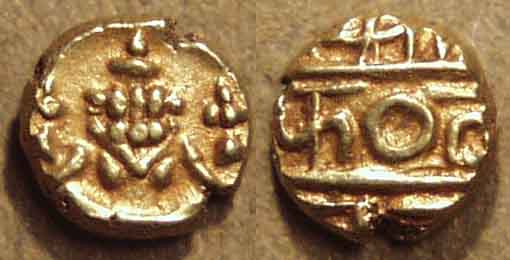
|
Kanthirava Narasa (1638-62) Gold fanam
Weight: 0.37 gm. Diameter: 5 mm Die axis: 2 o'clock
Narasimha (Lion-faced Vishnu) seated facing, holding a chakra in each upper hand
Partially visible Devanagari legend: Sri / Kamthi / rava
Reference: MNI 958, MSI 910-11
|
 |
The more usual "Kanthirava" fanam where the dots representing the face are in vertical lines.
|
 |
 |
 |
Immadi Krishna Raja Wodeyar II (1734-66) |
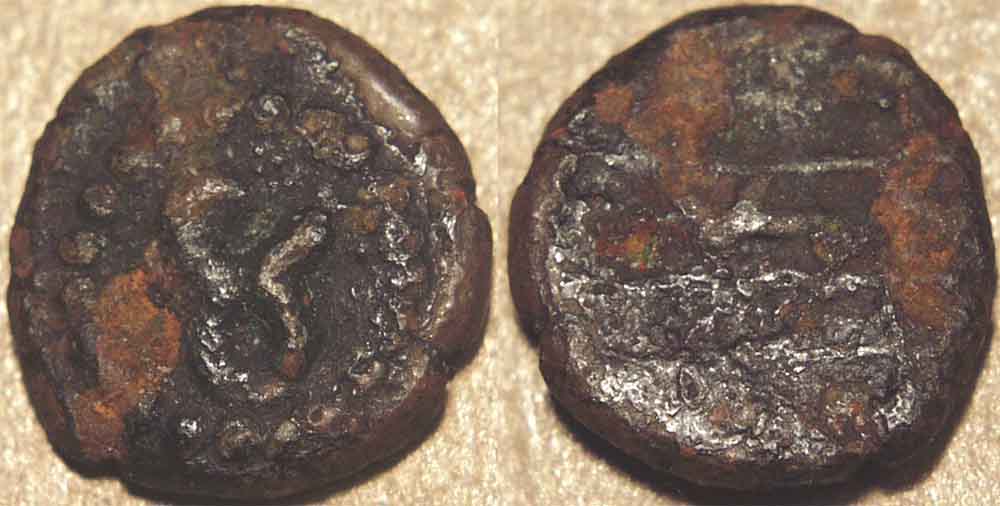
|
Devaloy Devaraja (1731-61), regent for Immadi Krishna Raja Wodeyar II (1734-66)
Copper kasu, Kannada Numeral Series, #4
Weight: 3.05 gm. Diameter: 13-14 mm Die axis: n.a.
Kannada numeral 4 within dotted border
Criss-cross lines
Reference: MNI 951 var, KM 165.4
|
 |
This coin belongs to the enigmatic Kannada numeral series. No one knows for sure who issued these coins, which are found almost
exclusively in Mysore state. Coins are known for numbers 1-33, with 1-31 being relatively common and 32-33 being rare. There is reportedly one known coin with the number 40,
but some have questioned the reading of this number and it does seem strange that a coin with 40 would exist, but no coins with the numbers 34-39 are known.
Perhaps the most widely accepted theory is that the numbers mark the regnal years of Immadi Krishna Raja Wodeyar II, who ascended the throne of Mysore at the age of 3 in
1734. His rule lasted 32 years, so this theory would require the assumption that the series was continued briefly after his death. A related theory also has the coins issued during
this reign, but argues that the numbers represent Hindu cyclic years.
I would like to propose a slightly different theory. We know that, during this period, the real power in Mysore lay with the Devaloys, powerful court officials who had consolidated
their control during a period of turmoil. Devaraja Devaloy seized control in 1731, while maintaining nominal fealty to Chamaraja (1731-34). What if these coins were issued by
Devaraja Devaloy, starting with year 1 in 1731 during the rule of Chamaraja, and continuing with the same series upon the inauguation of Immadi Krishna Raja II in 1734? When
Haidar Ali, the state's military commander, took control in 1761, he also continued to maintain a nominal fealty to Immadi Krishna Raja, and may have continued to issue coins in
the same series until he was ready to flex his muscles and commence mintage of coins in his own name.
|
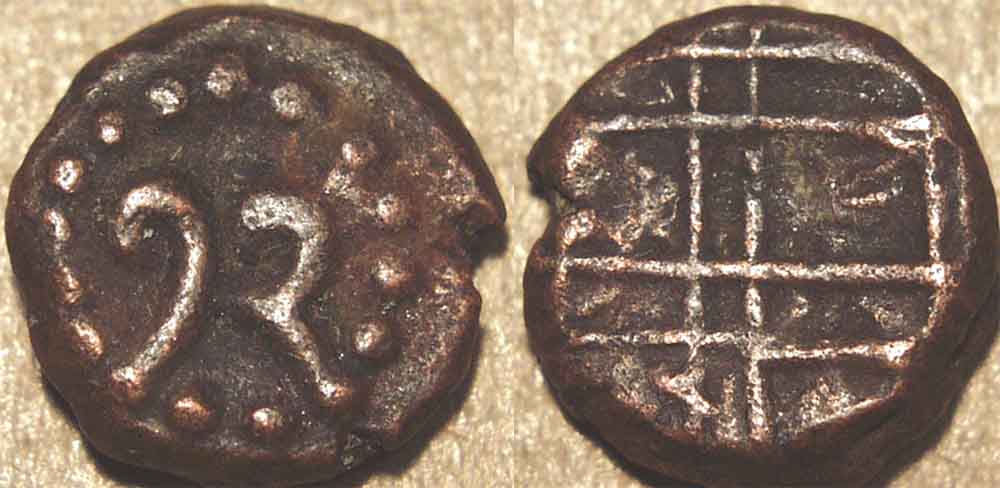
|
Devaloy Devaraja (1731-61), regent for Immadi Krishna Raja Wodeyar II (1734-66)
Copper kasu, Kannada Numeral Series, #23
Weight: 3.17 gm. Diameter: 13 mm Die axis: n.a.
Kannada numeral 23 within dotted border
Criss-cross lines
Reference: MNI 951 var, KM 165.23
|
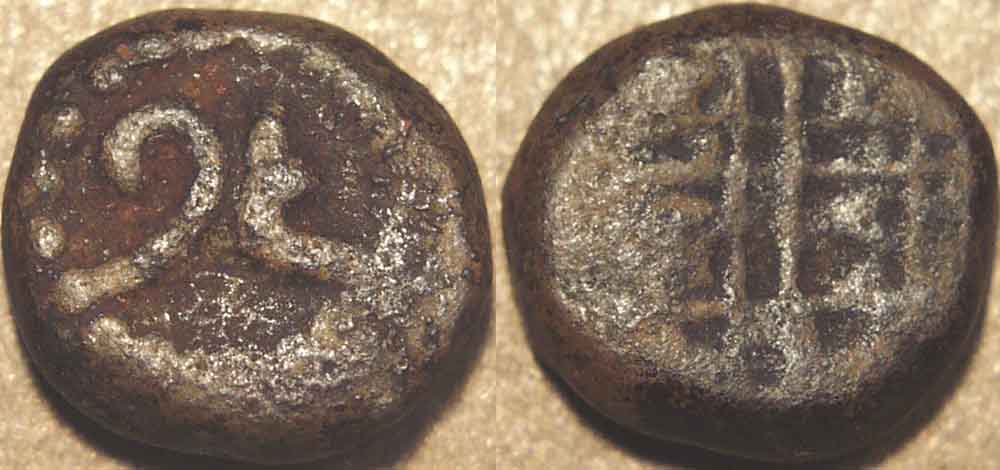
|
Devaloy Devaraja (1731-61), regent for Immadi Krishna Raja Wodeyar II (1734-66)
Copper kasu, Kannada Numeral Series, #26
Weight: 3.17 gm. Diameter: 11-12 mm Die axis: n.a.
Kannada numeral 26 within dotted border
Criss-cross lines
Reference: MNI 951 var, KM 165.26
|
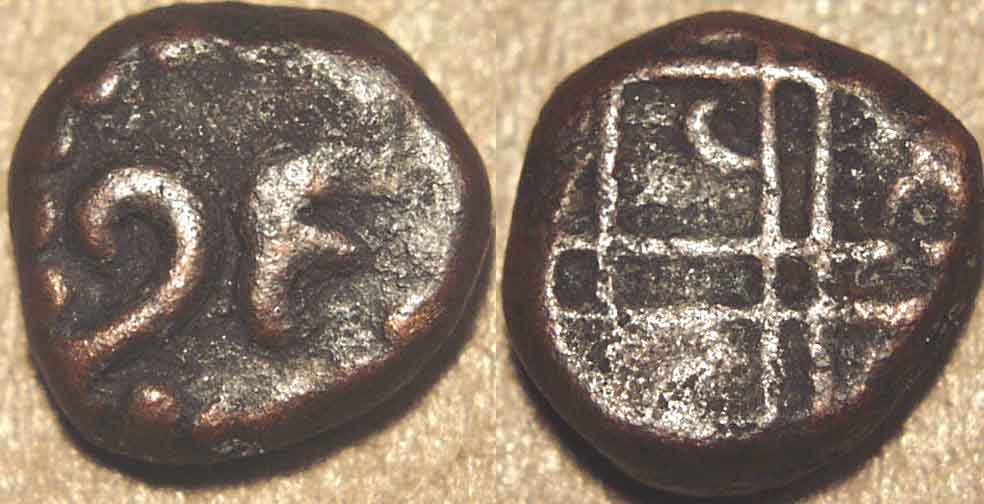
|
Devaloy Devaraja (1731-61), regent for Immadi Krishna Raja Wodeyar II (1734-66)
Copper kasu, Kannada Numeral Series, #29
Weight: 3.10 gm. Diameter: 11 mm Die axis: n.a.
Kannada numeral 29 within dotted border
Criss-cross lines
Reference: MNI 951 var, KM 165.29
|

|
Devaloy Devaraja (1731-61), regent for Immadi Krishna Raja Wodeyar II (1734-66)
Copper kasu, Elephant type, with crescent
Weight: 2.83 gm. Diameter: 11-13 mm Die axis: n.a.
Elephant left, crescent-like shape above, all within ruled and dotted borders
Criss-cross lines, with circles in the empty squares
Reference: MNI 963, KM 153
|
 |
This coin, with its reverse of criss-cross lines, probably was issued at the same time as the Kannada numeral series. The crescent
above the elephant may be thought to be the moon, but this is unlikely, given its inverted shape. More likely, it represents the Kananda numeral 1.
|
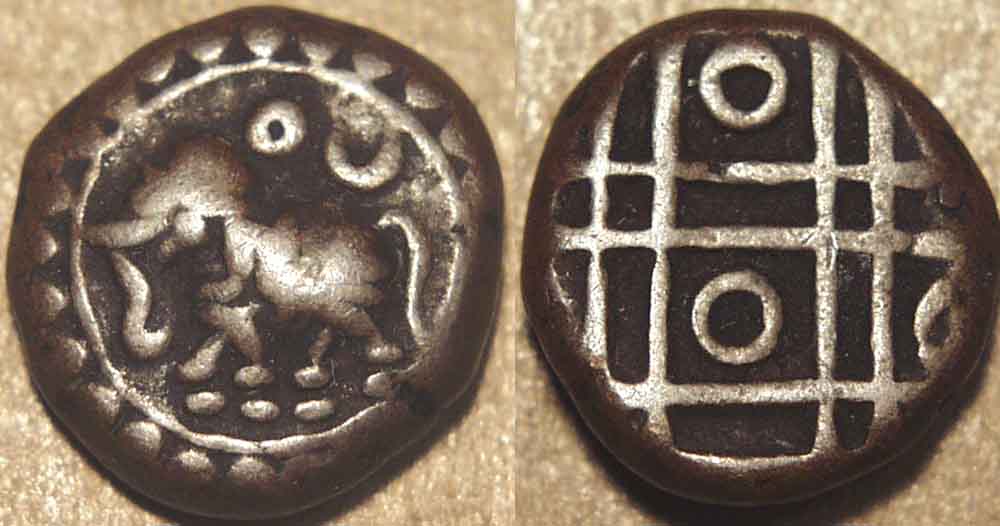
|
Devaloy Devaraja (1731-61), regent for Immadi Krishna Raja Wodeyar II (1734-66)
Copper kasu, Elephant type, with sun and moon
Weight: 2.77 gm. Diameter: 12 mm Die axis: n.a.
Elephant left, sun and moon above, all within ruled and dotted borders
Criss-cross lines, with circles in the empty squares
Reference: MNI 964-65, KM 152
|
|
|